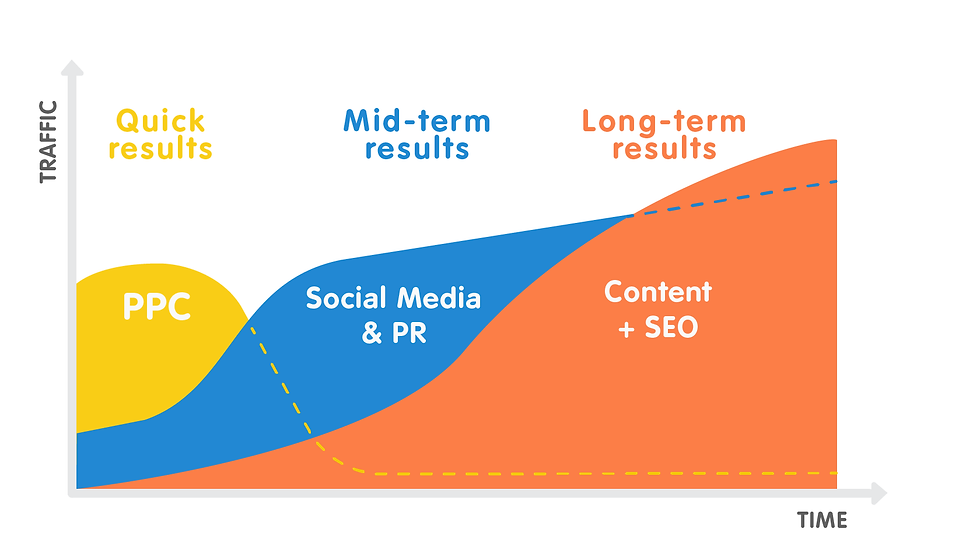SEO vs Paid Ads: What’s Best for Your Business?
- Planet Reach Media

- May 16
- 3 min read
Updated: May 29
In today’s digital-first economy, businesses must be discoverable online—or risk being left behind. But with so many channels and tactics available, choosing the right strategy can be overwhelming. Two of the most powerful tools at your disposal are Search Engine Optimization (SEO) and Paid Ads (also known as Pay-Per-Click or PPC). Both can drive traffic, leads, and revenue—but which is right for your business?
Let’s break down the differences, benefits, drawbacks, and when to use each.
What is SEO?
Search Engine Optimization is the process of improving your website’s visibility in organic (non-paid) search engine results. It focuses on optimizing the user experience, your content, your site structure, and your backlinks so that search engines like Google & Bing etc. will rank your site higher for relevant keywords.
According to smartinsights, Search engines are used by 81% of internet searchers, and SEO drives 1,000%+ more traffic than organic social media. That’s a massive opportunity for businesses looking for sustained, long-term growth.
Some Benefits of SEO:
Cost-effective over time: Once you’re ranking, clicks don’t cost you anything.
Long-term traffic: High-performing pages can drive traffic for years.
Brand trust: Users trust organic results more than ads.
Better user experience: SEO improvements often enhance site usability.
Drawbacks:
Slow results: SEO takes time—often 4 to 6 months to see traction.
Algorithm changes: Google updates can affect rankings unexpectedly.
High competition: Popular keywords may be dominated by major brands.
What are Paid Ads?
Paid Ads refer to placing advertisements on platforms like Google Ads, Meta (Facebook & Instagram), or YouTube, where you pay per click or impression. Unlike SEO, paid ads give you immediate visibility—but at a cost.
Google Ads, the most popular platform, controls over 28% of the global digital ad market (Statista, 2024). It allows businesses to appear at the top of search results instantly, even for highly competitive keywords.
Benefits of Paid Ads:
Instant traffic: Start generating clicks as soon as your campaign launches.
Precise targeting: Ads can target by demographics, location, behavior, and more.
Scalability: You can increase budget and reach instantly.
Trackable ROI: Every impression and click is measurable.
Drawbacks:
Costly: Competitive keywords can cost $10–$100+ per click.
Short-term: Once you stop paying, your visibility disappears.
Ad fatigue: Users may become blind to repeated ads.
SEO vs Paid Ads: Side-by-Side
Feature | SEO | Paid Ads |
Cost | Time investment, low ongoing cost | High ongoing budget |
Time to See Results | 4–6 months | Instant |
Traffic Quality | High-intent, trust-building | Targeted, but sometimes less engaged |
Long-Term ROI | High | Lower unless continuously optimized |
Control & Targeting | Limited | Highly customizable |
Click-Through Rate | Higher on average (28.5% for top organic result — Backlinko) | Lower, varies by ad quality |
When to Use SEO
SEO is ideal if you:
Want to build authority and trust over time.
Have a limited advertising budget but can invest time.
Want compounding value—the more content you build, the more traffic you get.
Are targeting informational searches (e.g., “How to plan a wedding in the Caribbean”).
"Check out our Search Engine Optimization services Here."
When to Use Paid Ads
Paid ads work best when:
You need fast results (e.g., launching a product or seasonal promotion).
You have specific targeting needs (location, behavior, interests).
You're testing new offers or landing pages.
You want to retarget visitors and stay top-of-mind.
"Check out our Paid Advertising services Here."
The Best Strategy? Use Both.
The most successful brands use SEO and Paid Ads together, creating a full-funnel strategy:
Use SEO to build long-term organic traffic and brand authority.
Use PPC for quick wins, lead generation, and retargeting.
Use data from PPC to inform SEO content (e.g., which keywords convert best).
According to HubSpot, businesses using both organic and paid strategies generate 27% more revenue than those using just one.

Final Thoughts
So, what’s best for your business—SEO or paid ads? The answer isn’t black and white. If you’re looking for quick results, go with paid ads. If you’re aiming for sustainable, long-term growth, SEO is essential. But if you’re serious about dominating your market, combining both will give you the competitive edge you need.
At Planet Reach Media, we help brands grow with integrated strategies that balance long-term organic visibility and short-term conversion wins. Want to know what strategy will work best for your business?







Comments